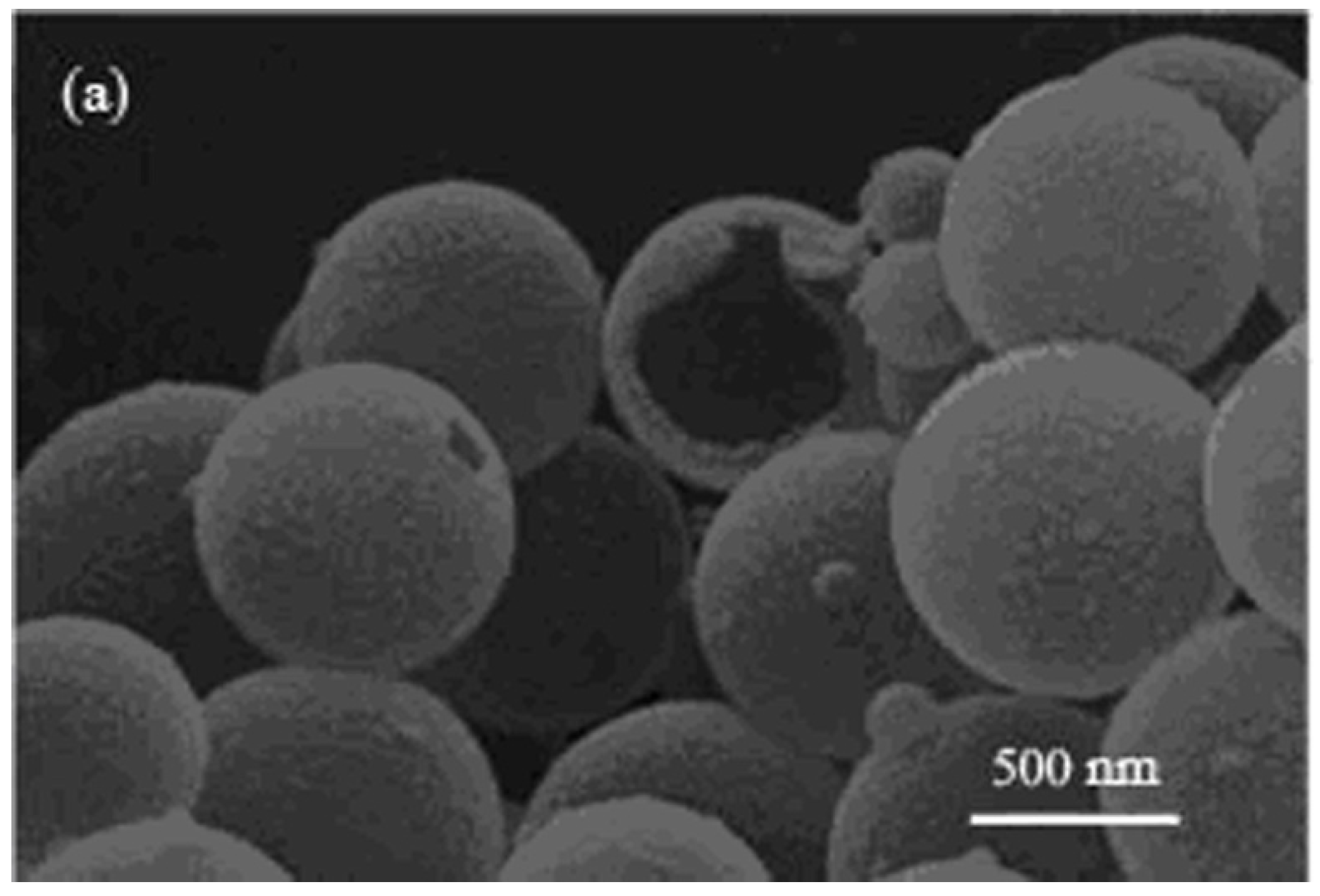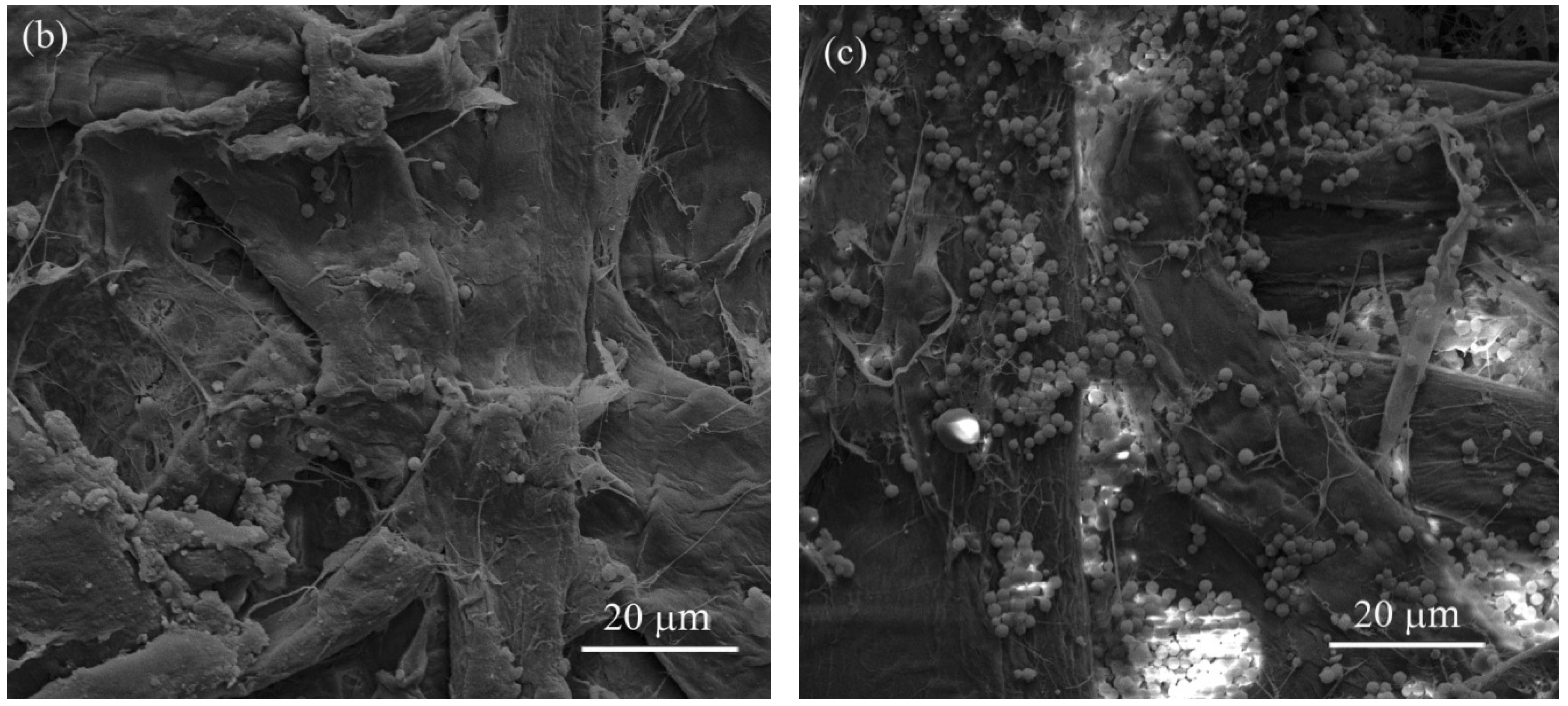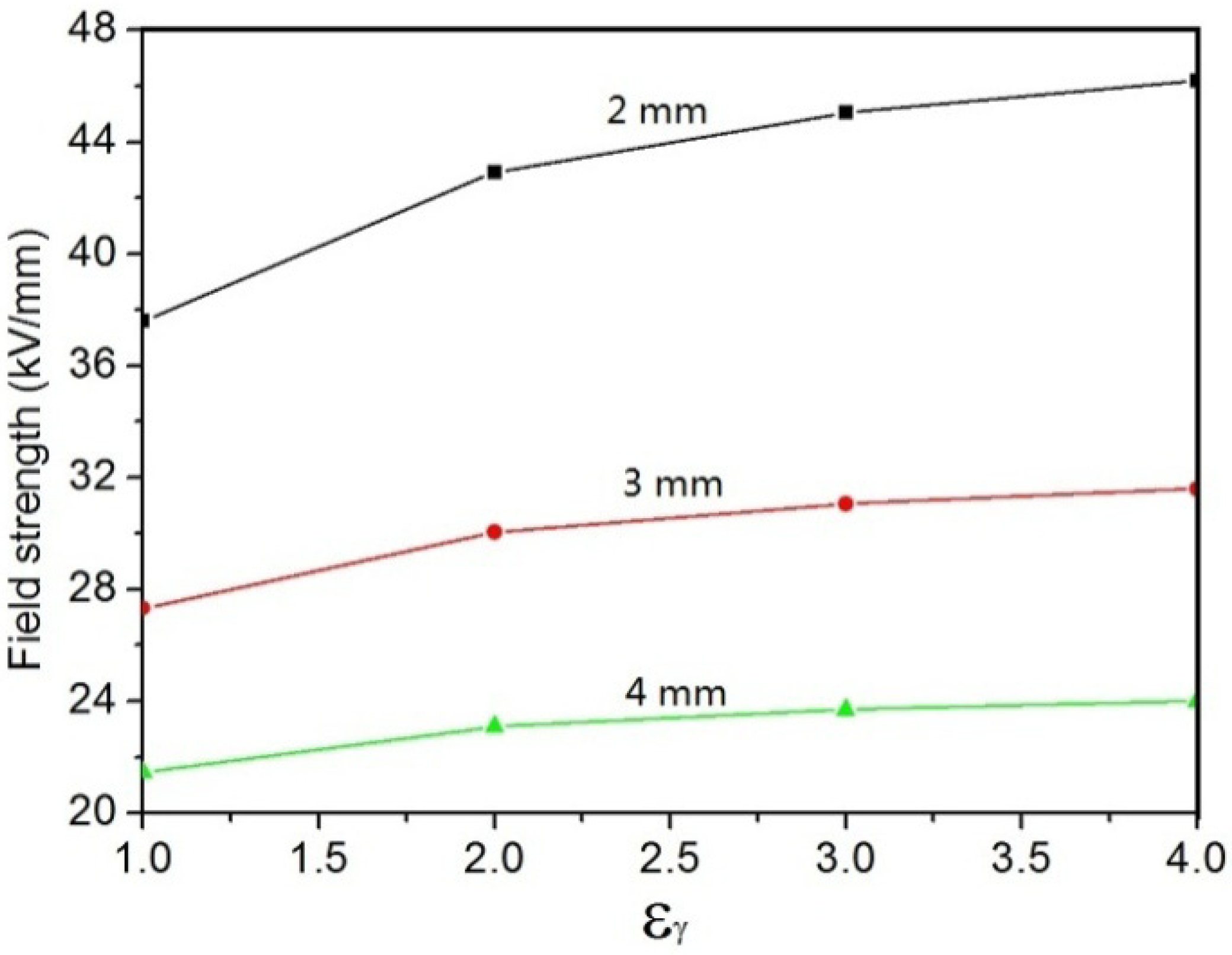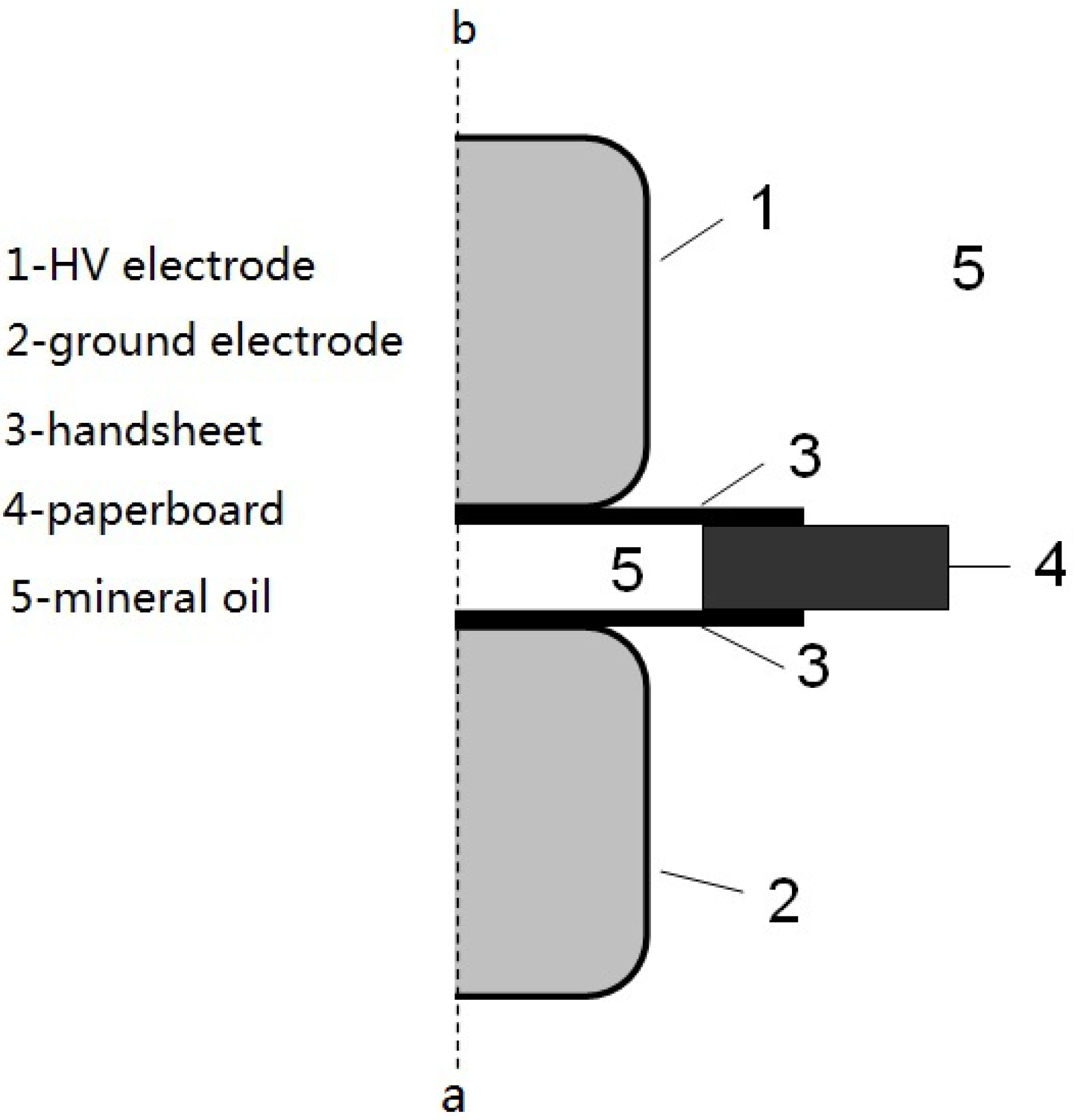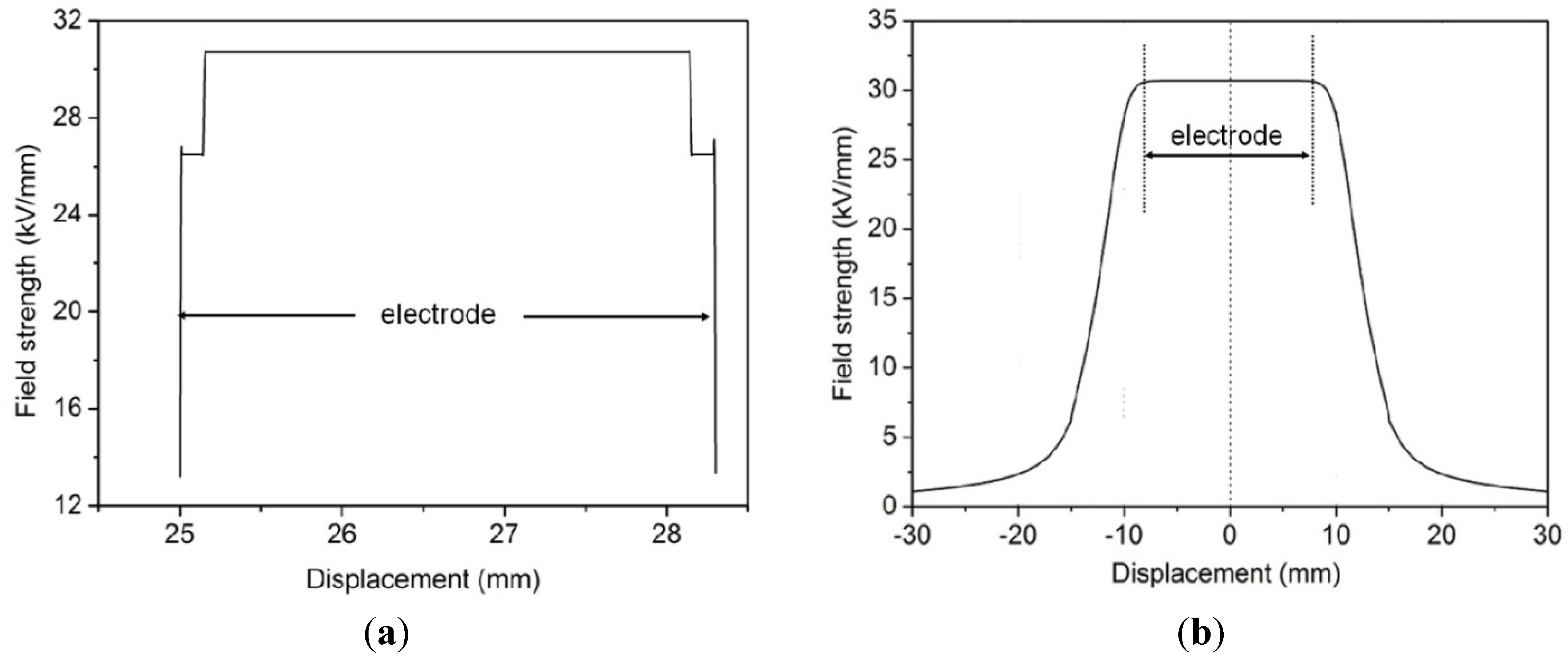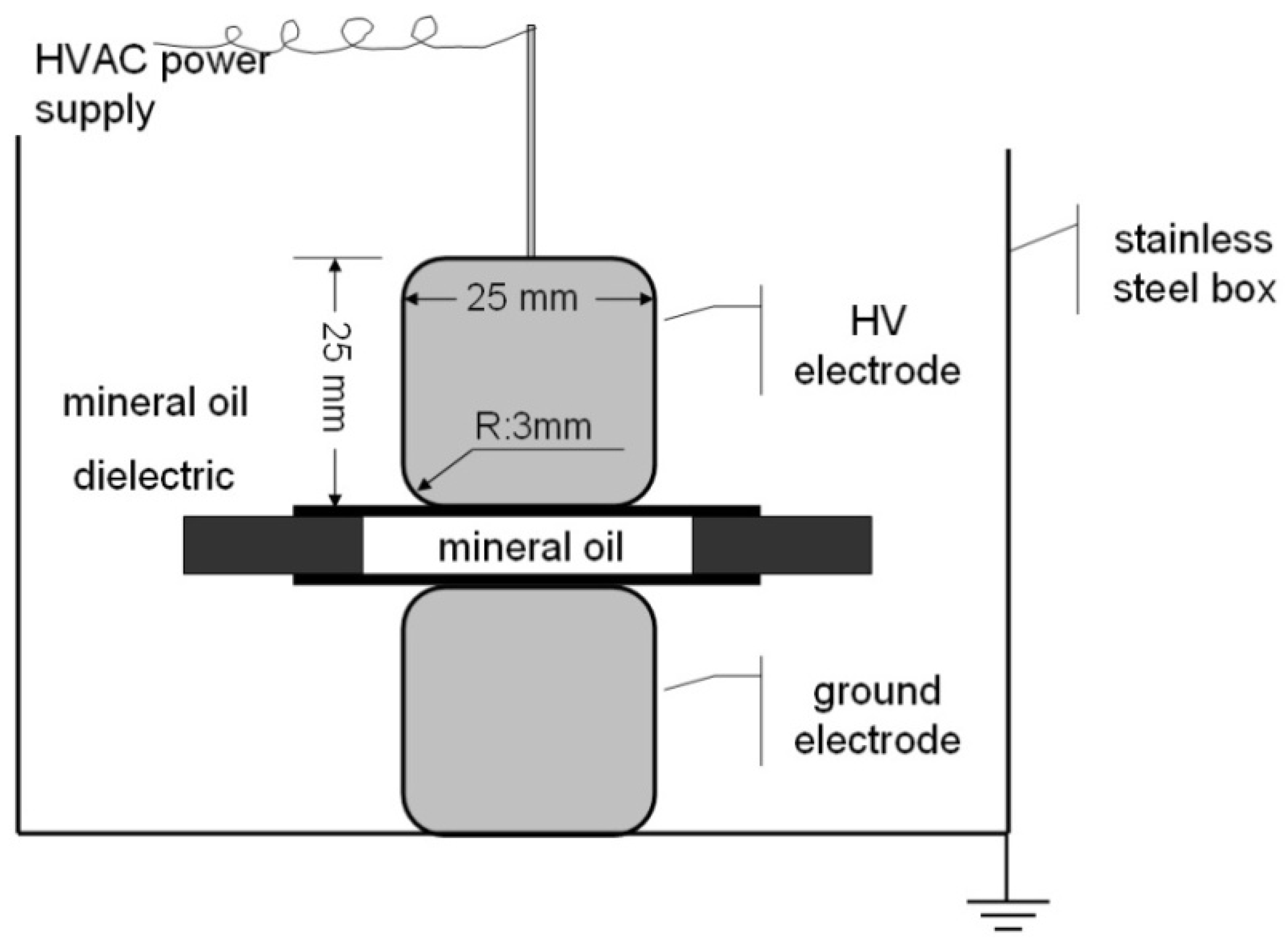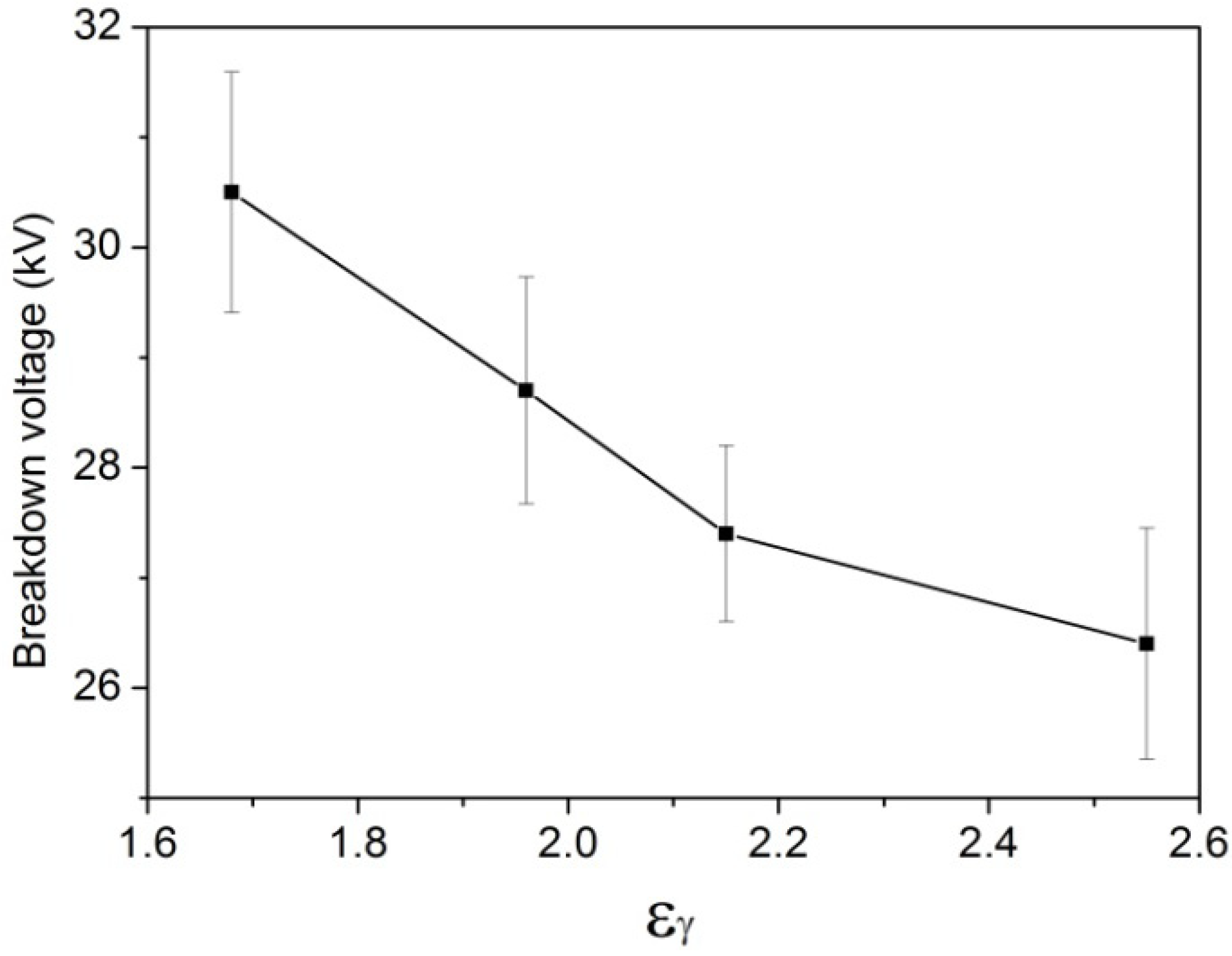1. Introduction
Kraft, a form of cellulose insulation, is widely used in oil-filled transformer equipment [
1,
2,
3,
4,
5]. Kraft is the preferred insulation for all oil-filled transformers because of its low cost and reasonably good performance. The relative permittivity of immersed oil Kraft is about 4.4, or more than twice that of oil (2.1). Thus, the oil gap shares a higher electric field strength [
6]. The electric field strength of the oil gap becomes lower if the relative permittivity of Kraft is reduced. Uniform electric field distributions can be achieved in paper-oil-paper composite insulation systems. Therefore, the insulating distance in transformers can also be decreased. In the previous work of our group, low relative permittivity polyimide (PI)-SiO
2 films were successfully prepared using SiO
2 hollow spheres with different weight percentages [
7,
8]. The relative permittivity of the composites decreased from 2.3 (pure PI) to 1.8, and then increased to 2.7.
In the present work, Kraft-SiO2 hollow sphere insulation paper handsheets (K-SiO2) were obtained. The distribution of the SiO2 hollow spheres in the handsheets were observed by scanning electron microscopy (SEM). The effect of the content of the SiO2 hollow spheres on the relative permittivity of the oil-immersed handsheets was investigated by broadband dielectric spectroscopy. The electric field distribution of a double-layer dielectric was calculated. Breakdown tests of the paper-oil-paper composite insulation system with different relative permittivity papers were also performed.
2. Preparation of SiO2 Hollow Spheres and Low Relative Permittivity Handsheets
The SiO
2 hollow sphere powder was prepared by the method of Chen [
2,
7,
9]. The powder was calcined at 500 °C for 6 h before use to remove any remaining polystyrene. The SiO
2 hollow spheres could be clearly observed. They were regular spheres about 500 nm in diameter (
Figure 1a). The hollow structure of the spheres was confirmed by the breakage.
The SiO
2 hollow spheres were dissolved in deionized water (1:100 wt %) and the slurry was homogenized by vigorous agitation with a magnetic stir bar for 10 min. SiO
2 hollow spheres with different weight percentages were added to Kraft pulps. The mixtures were stirred for 3 min at 3000 r/min in a fiber disintegrating device, and were used to prepare the handsheets. Each wet handsheet was pressed at 15 MPa for 5 min at 80 °C, and dried at 105 °C for 7 min under a vacuum. Handsheets with a target basis weight of 120 g/m
2 were produced. SiO
2 hollow spheres with a low content were uniformly dispersed as almost individual particles in the matrix (
Figure 1b). The SiO
2 hollow spheres locally aggregated with increased concentration (
Figure 1c).
Figure 1.
Scanning electron microscopy (SEM) images of (a) SiO2 hollow spheres; (b) K-3% SiO2, and (c) K-7% SiO2.
Figure 1.
Scanning electron microscopy (SEM) images of (a) SiO2 hollow spheres; (b) K-3% SiO2, and (c) K-7% SiO2.
The contents of SiO2 hollow spheres in the handsheets were 0%, 3%, 5%, and 7%, and they were thus designated as Kraft, K-3% SiO2, K-5% SiO2, and K-7% SiO2, respectively.
The relative permittivities of Kraft (immersed oil) composed of SiO
2 hollow spheres were tested at different frequencies ranging from 10
−2 Hz to 10
7 Hz at 25 °C (
Figure 2). The variation trends of the four samples were similar. The changes in the relative permittivities were moderate from 1 Hz to 10
7 Hz, and dramatic under 1 Hz.
Figure 2.
Effect of SiO2 hollow sphere content on the relative permittivity of insulation paper.
Figure 2.
Effect of SiO2 hollow sphere content on the relative permittivity of insulation paper.
The relative permittivities of the K-SiO
2 (K-3% SiO
2, K-5% SiO
2, and K-7% SiO
2) composites were lower than that of Kraft under different frequencies. The relative permittivity of air is 1.0. Thus, air voids stored in SiO
2 hollow spheres are one cause of reduced relative permittivity [
10]. The existence of SiO
2 hollow spheres improves the distance of fiber chains. The oil content of handsheets increases due to air voids in the composites [
11]. Therefore, the relative permittivity decreases [
12,
13,
14,
15,
16]. Noticeably, the relative permittivity (at 50 Hz) of the composites decreased from 2.55 (Kraft) to 1.68 (K-5% SiO
2), and then increased to 1.95 (K-7% SiO
2). K-5% SiO
2 exhibited the lowest relative permittivity. A low content of SiO
2 hollow spheres (<5%) improved the distance of fiber chains. Thus, the relative permittivity decreased. A higher content of SiO
2 hollow spheres (7%) could fill the air voids in the composites; consequently, the air voids became smaller and the relative permittivity increased. The order of permittivity was Kraft > K-3% SiO
2 > K-7% SiO
2 > K-5% SiO
2.
The tensile strength of the handsheets was reduced with the addition of SiO2 hollow spheres. The main reason was the existence of a weak interface between the fiber and SiO2 hollow spheres. The tensile strengths of Kraft, K-3% SiO2, K-5% SiO2 and K-7% SiO2 were 9.09 kN/m, 8.97 kN/m, 8.89 kN/m and 8.53 kN/m respectively. The tensile strength didn't show a sharp decline with K-SiO2.
3. Double-Layer Dielectric Theory
The electric field strength of a double-layer dielectric is inversely proportional with the relative permittivity under an alternating current (AC) voltage. The electric field formula in a double-layer dielectric can be defined as:
where
E1 and
E2 are the electric fields of medias 1 and 2, respectively;
U is the total electrical voltage;
ε1 and
ε2 are the relative permittivities of medias 1 and 2, respectively; and
d1 and
d2 are the thicknesses of medias 1 and 2, respectively.
Evidently, Equations (1) and (2) above are only suitable for two media. In the current experiment, although the paper-oil-paper composite insulation systems had three layers of media, these media were only of two kinds. Thus, the electric field strengths could be calculated using Equations (1) and (2). The thickness of the oil gap was designated as do (2, 3, and 4 mm). The relative permittivity of oil is 2.2; hence, the thickness of the paper was assumed to be 0.15 mm. The AC supply voltage was fixed at 100 kV.
The effect of the relative permittivity of the insulation paper on the electric field strength of the oil gap is shown in
Figure 3. The variation trends in the different kinds of oil gaps were similar. The electric field strength of the oil gap decreased with decreased relative permittivity of the paper. However, under small thicknesses of the oil gap, the electric field strength of the oil gap significantly changed with the relative permittivity of the paper. When the relative permittivity of the paper decreased from 4 to 1 and the thicknesses of the oil gap
do were 4, 3, and 2 mm, the electric field strength of the oil gap decreased by 10.6%, 13.6%, and 18.5%, respectively.
The effect of the relative permittivity of the insulation paper on its electric field strength is shown in
Figure 4. The variation trends in the different kinds of oil gaps were also similar. The electric field strength of the insulation paper decreased with increased relative permittivity of the paper. However, under large thicknesses of the oil gap, the electric field strength of the insulation paper significantly changed with its relative permittivity. The distribution trend was opposite with that in
Figure 3. When the relative permittivity of the paper decreased from 4 to 1 and the thicknesses of the oil gap
do were 4, 3, and 2 mm, the electric field strength of the insulation paper increased by 257.6%, 245.4%, and 225.6%, respectively.
Figure 3.
Effect of the relative permittivity of the insulation paper on the electric field strength (E1) of the oil gap under three kinds of oil gap thicknesses.
Figure 3.
Effect of the relative permittivity of the insulation paper on the electric field strength (E1) of the oil gap under three kinds of oil gap thicknesses.
Figure 4.
Effect of the relative permittivity of the insulation paper on its electric field strength (E2) under three kinds of oil gap thicknesses.
Figure 4.
Effect of the relative permittivity of the insulation paper on its electric field strength (E2) under three kinds of oil gap thicknesses.
4. Breakdown Experiment of a Paper-Oil-Paper Composite Insulation System
A uniformly distributed electric field between two test electrodes was proven by simulation analysis.
Figure 5 depicts the computational domain for the dielectric test electrode. Line ab is the symmetry axis of electrode. The developed model was built under two-dimensional axial symmetry configurations and implemented using a COMSOL Multiphysics
® package based on the finite element method. A sinusoidal voltage of 50 Hz with a peak value of 100 kV, was applied to the dielectric test setup.
Figure 5.
Computational domain.
Figure 5.
Computational domain.
The electric field distribution between the two test electrodes is shown in
Figure 6. The two test electrodes (
Figure 5) had a range of 25 mm to 28.3 mm (
Figure 6a) and −9.5 mm to 9.5 mm (
Figure 6b). The electric field of paper or oil was uniform along the direction of line ab between the two test electrodes (
Figure 6a). The curve (
Figure 6b) shows the electric field distribution of oil along the vertical direction of line ab. The electric field distribution of paper along the vertical direction of line ab was in accordance with that in
Figure 6b. Thus, the electric field of paper or oil was also uniform in the vertical direction of line ab between the two test electrodes. Therefore, the electric field distribution between the two test electrodes was uniform.
Figure 6.
Electric field distribution: (a) line ab is the x-axis, and the bottom center of the ground electrode is the origin; (b) the vertical direction of line ab is the x-axis, and the center of the oil gap is the origin.
Figure 6.
Electric field distribution: (a) line ab is the x-axis, and the bottom center of the ground electrode is the origin; (b) the vertical direction of line ab is the x-axis, and the center of the oil gap is the origin.
The diagram of the electrodes for measuring the breakdown voltage of the handsheets is shown in
Figure 7. The diameter and height of the high-voltage (HV) and ground electrodes were both 25 mm. A copper bar was used to connect the HV electrode with the HV AC current power. In this test, mineral oil was used for the dielectric in the stainless steel box.
Figure 7.
Diagram of electrodes.
Figure 7.
Diagram of electrodes.
The focus of the experiment was the effect of the relative permittivity on the breakdown voltage of the composite insulation system. Therefore, the thickness of the oil gap was only 3 mm. The oil gap was formed in the 3 cm-diameter hole of the 3 mm-thick paperboard. The external diameter of the paperboard was 6 cm. The thickness of the four kinds of experimental handsheet papers (Kraft, K-3% SiO2, K-5% SiO2, and K-7% SiO2) were 0.15 mm in this experiment. Their relative permittivities at 50 Hz were 2.55, 2.15, 1.68, and 1.96, respectively. The handsheet papers were cut into 4 cm-diameter circles. All samples were put into the vacuum chamber and were dried at 90 °C for 48 h, and then the mineral oil at 40 °C was infused into the glass bottles in the vacuum chamber to immerse samples for 24 h. The moisture content of oil impregnated paper was 0.4% through such processing.
The effect of the relative permittivity of the handsheet on the breakdown voltage of the composite insulation system is shown in
Figure 8. The breakdown voltage of the paper-oil-paper composite insulation system increased from 26.4 kV to 30.5 kV with decreased relative permittivity of the paper from 2.55 to 1.68.
Figure 8.
Effect of the handsheet relative permittivity on the breakdown voltage of the composite insulation system.
Figure 8.
Effect of the handsheet relative permittivity on the breakdown voltage of the composite insulation system.
